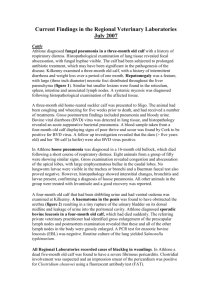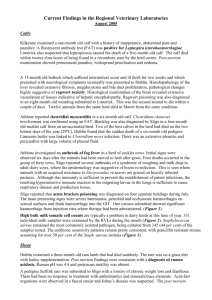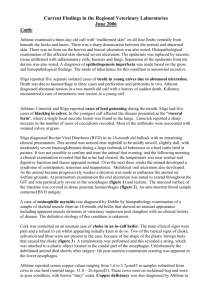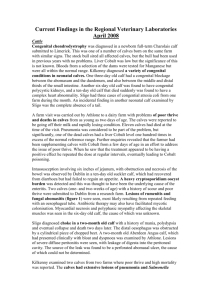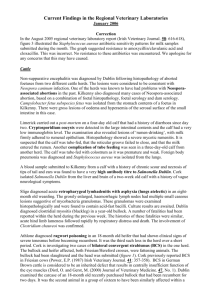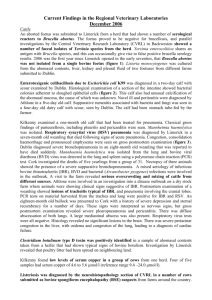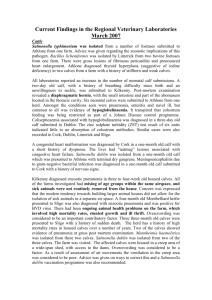May 2007
advertisement
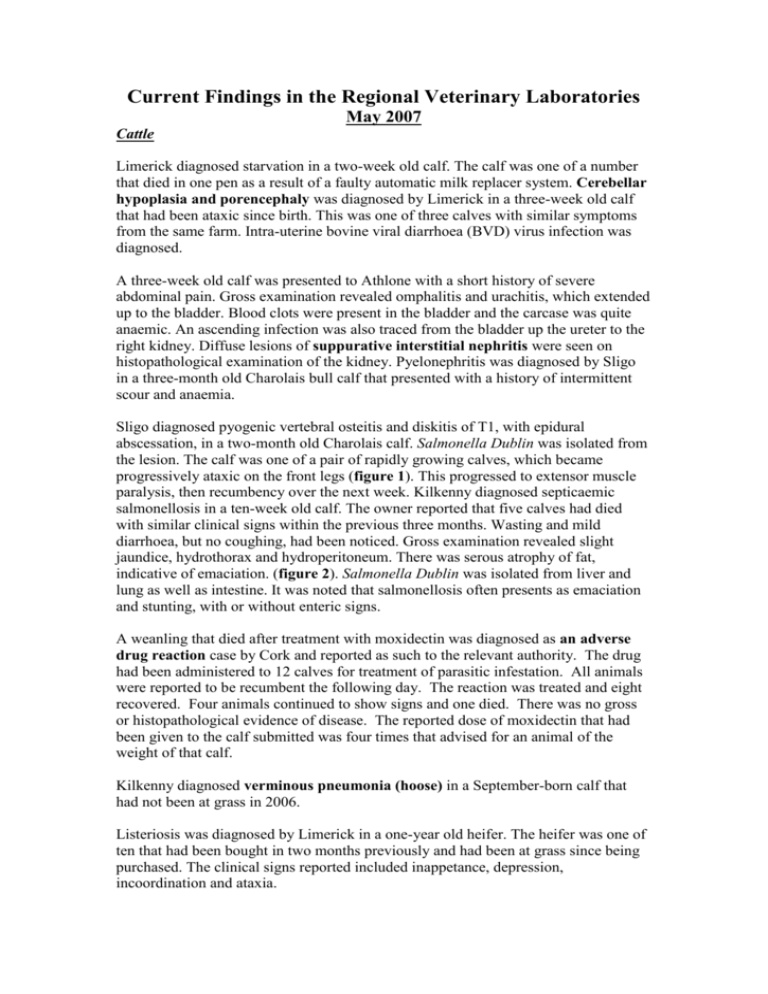
Current Findings in the Regional Veterinary Laboratories May 2007 Cattle Limerick diagnosed starvation in a two-week old calf. The calf was one of a number that died in one pen as a result of a faulty automatic milk replacer system. Cerebellar hypoplasia and porencephaly was diagnosed by Limerick in a three-week old calf that had been ataxic since birth. This was one of three calves with similar symptoms from the same farm. Intra-uterine bovine viral diarrhoea (BVD) virus infection was diagnosed. A three-week old calf was presented to Athlone with a short history of severe abdominal pain. Gross examination revealed omphalitis and urachitis, which extended up to the bladder. Blood clots were present in the bladder and the carcase was quite anaemic. An ascending infection was also traced from the bladder up the ureter to the right kidney. Diffuse lesions of suppurative interstitial nephritis were seen on histopathological examination of the kidney. Pyelonephritis was diagnosed by Sligo in a three-month old Charolais bull calf that presented with a history of intermittent scour and anaemia. Sligo diagnosed pyogenic vertebral osteitis and diskitis of T1, with epidural abscessation, in a two-month old Charolais calf. Salmonella Dublin was isolated from the lesion. The calf was one of a pair of rapidly growing calves, which became progressively ataxic on the front legs (figure 1). This progressed to extensor muscle paralysis, then recumbency over the next week. Kilkenny diagnosed septicaemic salmonellosis in a ten-week old calf. The owner reported that five calves had died with similar clinical signs within the previous three months. Wasting and mild diarrhoea, but no coughing, had been noticed. Gross examination revealed slight jaundice, hydrothorax and hydroperitoneum. There was serous atrophy of fat, indicative of emaciation. (figure 2). Salmonella Dublin was isolated from liver and lung as well as intestine. It was noted that salmonellosis often presents as emaciation and stunting, with or without enteric signs. A weanling that died after treatment with moxidectin was diagnosed as an adverse drug reaction case by Cork and reported as such to the relevant authority. The drug had been administered to 12 calves for treatment of parasitic infestation. All animals were reported to be recumbent the following day. The reaction was treated and eight recovered. Four animals continued to show signs and one died. There was no gross or histopathological evidence of disease. The reported dose of moxidectin that had been given to the calf submitted was four times that advised for an animal of the weight of that calf. Kilkenny diagnosed verminous pneumonia (hoose) in a September-born calf that had not been at grass in 2006. Listeriosis was diagnosed by Limerick in a one-year old heifer. The heifer was one of ten that had been bought in two months previously and had been at grass since being purchased. The clinical signs reported included inappetance, depression, incoordination and ataxia. Four cases of lead poisoning were diagnosed by Sligo in May. Two heifers with a history of sudden death had tiny fragments of lead in the reticulum and toxic levels in their kidneys. The source was a discarded sealed lead accumulator battery, which had probably split during the winter frosts, exposing the toxic plates. The two other cases from two separate herds were presented on the same day, both with a history of neurological signs. The fatalities were confined to animals in the same field in each herd. Lead sources were subsequently located in the fields that the dead animals were grazing in. Athlone and Kilkenny also reported cases of lead poisoning in cattle. Sheep Sligo diagnosed pulpy kidney and tick-pyaemia in lambs during the month. A hogget submitted to Cork was confirmed to have died from uraemia following urolithiasis. The animal was one of a number that died in a flock of over 1,000 being fattened for slaughter. The chemical composition of the deposits was not confirmed, but phosphates were suspected. The lambs were being heavily supplemented with grain with no calcium balancer added. Sligo diagnosed poisoning due to andromedotoxin in two adult ewes, which died suddenly after having broken in to a garden. Leaves from the lily-of-the-valley shrub (Pieris japonica) (figure 3) were discovered in both rumens. These leaves of this small garden plant seem to be much more poisonous than those of the common rhododendron (Rhododendron ponticum), which contain the same toxin. Typical clinical signs include abdominal pain, teeth grinding, vomiting, staggering and lateral recumbency. Poultry Fowl cholera was suspected by Cork in a back-yard flock. Although Pasteurella was isolated, the species was not confirmed, but the history and clinical signs (including swollen wattles) suggested cholera was present and action was taken on that basis. Ten percent of 7,000 recently hatched partridge chicks died, and several were submitted to Cork. The weights of the chicks submitted were very uneven, ranging from seven to ten grams, and several had evidence of yolk sac infections. Mishandling of the eggs with possible temperature fluctuations from laying to hatching was suspected. The eggs had been imported from France. Other Species Pasteurella pneumotropica was isolated from a two-day old foal with lesions of septicaemia presented to Limerick. A foal that died neonatally and hadn't passed meconium was presented to Sligo. The entire gastro-intestinal tract was packed with hard, dried out meconium. The foal was sero-positive to Equine Herpes Virus 4 (EHV4). Limerick diagnosed Strongyloides westeri infestation in a four-week-old foal. The foal had not been seen sick, but post-mortem examination showed lesions of enteritis and dehydration. There was an egg count of 20,000 eggs per gram of faeces. Athlone carried out a postmortem examination on a one-month old foal with a history of severe diarrhoea. Salmonella typhimurium was isolated from the liver and intestines. The zoonotic significance of the pathogen was relayed to the relevant parties. A farmed deer was submitted to Kilkenny with a history of sudden death. Gross lesions of haemorrhagic cystitis were seen. Histopathological examination confirmed the haemorrhagic cystitis and found vascular lesions suggestive of malignant catarrhal fever. Sheep are kept on the same farm but the degree of contact between the species is not known. Two reindeer (Rangifer tarandus), an adult male and a young female, were presented to Athlone following sudden death. The owner feared that they had gained access to stored barley. Post mortem examination ruled out ruminal acidosis as a possible diagnosis. No significant bacterial pathogen was isolated on routine culture but histopathological examination of a selection of tissue samples revealed changes consistent with a gram-negative septicaemia. Based on the clinical history and gross findings, yersiniosis was considered to be a possible diagnosis. Stress can have a significant role in the pathogenesis of this disease (transportation, change of diet etc.) Treatment with long acting tetracycline is considered to be of benefit in preventing the development of further cases. An emaciated adult male badger (Meles meles) weighing 5.3 Kg was presented to Kilkenny. Gross, microscopic and cultural examinations were negative for tuberculosis. There was however a circular skin wound of approximately four centimetres in diameter at the base of the tail. Histopathological examination revealed a suppurative panniculitis with granulation tissue. Streptococcus canis was isolated from the wound. Cork isolated a Salmonella unnamed – subspecies 111b, from a goanna (a species of Australian monitor lizard) submitted from a wildlife park. Salmonella subspecies 111b is of zoonotic significance. CAPTIONS FOR PHOTOS Figure 1 “Front limb ataxia in a calf with epidural abscessation– photo Martin O’Malley” Or Figure 1 “Spinal cord compression associated with epidural abscessation in a Charolais calfphoto Colm O’Muireagáin” Figure 2 “Serous atrophy of perirenal fat in a ten-week old calf with septicaemic salmonellosis– photo Donal Toolan” Figure 3 “The leaves of Pieris japonica- photo Paul Brennan”
